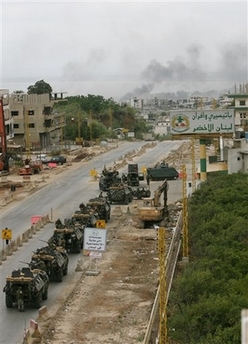 By BASSEM MROUE, Associated Press Writer, TRIPOLI, Lebanon June 1 – 2007- Under the cover of artillery barrages, dozens of Lebanese army tanks and armored carriers moved toward a Palestinian refugee camp in northern Lebanon Friday in pursuit of Islamic militants holed up inside. The artillery bombardment sent white clouds rising above the Nahr el-Bared camp, where Fatah Islam militants have been hanging on in a 13-day siege by the Lebanese army. The shelling also ignited fires in the camp that spewed black smoke. The militants have barricaded themselves in residential neighborhoods of narrow, winding streets and apartment buildings.
By BASSEM MROUE, Associated Press Writer, TRIPOLI, Lebanon June 1 – 2007- Under the cover of artillery barrages, dozens of Lebanese army tanks and armored carriers moved toward a Palestinian refugee camp in northern Lebanon Friday in pursuit of Islamic militants holed up inside. The artillery bombardment sent white clouds rising above the Nahr el-Bared camp, where Fatah Islam militants have been hanging on in a 13-day siege by the Lebanese army. The shelling also ignited fires in the camp that spewed black smoke. The militants have barricaded themselves in residential neighborhoods of narrow, winding streets and apartment buildings.
It was unclear from reports on the ground whether the army had penetrated deep into the camp, or limited its advance to outer neighborhoods that militants had used to direct sniper fire at army positions. Nahr el-Bared, like the other 11 Palestinian camps in Lebanon, has been off limits to Lebanese authorities under a nearly 40-year-old agreement that stipulated Palestinians would run their own affairs. Two soldiers were slightly wounded in Friday’s fighting, according to officials at a local hospital.About 50 armored carriers, battle tanks and military vehicles from elite units massed at the northern edge of the camp and drove toward the forward-most positions, according to an AP Television News crew at the scene.
There was no confirmation that army units were making a final push to take over the camp or were just advancing to grab territory and isolate the militants. But a significant decrease in shelling accompanied by a rise in machine gun fire from armored carriers and exchanges of automatic rifle fire suggested the troops were already engaging the militants.
The bombardment intensified several hours later. Lebanese Broadcasting Corp. said troops were attempting to seize the main offices of Fatah Islam in the camp’s northeastern area. But Al-Arabiya television said troops seized militant sniper positions.
A resident said some Fatah Islam positions were overtaken and destroyed in the push. He spoke from inside the camp on condition of anonymity for fear of reprisals.
"What we have decided is to deal with Fatah Islam as a group, a terrorist group taking hostages who are left in the camp," said Telecommunications Minister Marwan Hamadeh. He told Associated Press Television News in Beirut that the army may be seeking to isolate the militants.
"I think the army is determined this time to go ahead and probably to reduce several pockets of Fatah Islam terrorist," he said.
Cabinet Minister Ahmed Fatfat told Al-Arabiya television that the army came under sniper fire earlier Friday and decided to respond. "It seems they have destroyed those positions."
A soldier on standby in a unit of 10 armored carriers and two tanks on the camp’s edge said troops were advancing slowly and fighting building to building, after bombing positions in the morning.
"They are in very well-fortified positions," he said of the militants, saying troops were coming under sniper fire. He spoke on condition of anonymity because he was not authorized to speak with the media.
Television footage showed the movement of T-55 Russian-made tanks, French-made Panhard tanks, M-113 U.S.-built armored personnel carriers and jeeps with 106mm rifles mounted on them. Sandbags were packed on some of the vehicles.
Military officials would not comment on the troop movements and journalists were pushed back further from the camp. But a statement by the army command said troops came under fire from the militants and the army was "responding with accurate and decisive fire to deter them." The statement said the army was at the same time avoiding civilian casualties.
Sporadic gunfire exchanges have continued daily since a truce halted three days of heavy fighting.
A Lebanese soldier was killed by Islamic militants’ sniper fire on Thursday, raising to 32 the number of soldiers killed since fighting between the army and Fatah Islam militants began on May 20. At least 20 civilians and about 60 militants also have been killed.
Thousands of Palestinians have fled the camp, but thousands more are still inside, along with the Fatah Islam fighters.



